OF SMALL OUTBOARD MOTORS
I’ve used an electric outboard for many years, and like them very much, indeed. Electrics are silent, and in quiet water they are positively elegant, operating without stink or smoke. Among their other virtues they’re much cheaper than gasoline motors and much lighter, for the same power. For 19 years of hunting and fishing on the New 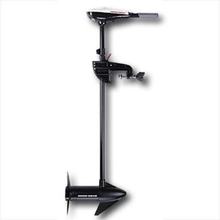 River I’d exclusively used the largest 12-volt motors Minn-Kota makes. I now have a 12-volt "Endura" 50-pound motor (left) roughly equivalent to an older "3-HP" model that I burned out.
River I’d exclusively used the largest 12-volt motors Minn-Kota makes. I now have a 12-volt "Endura" 50-pound motor (left) roughly equivalent to an older "3-HP" model that I burned out.
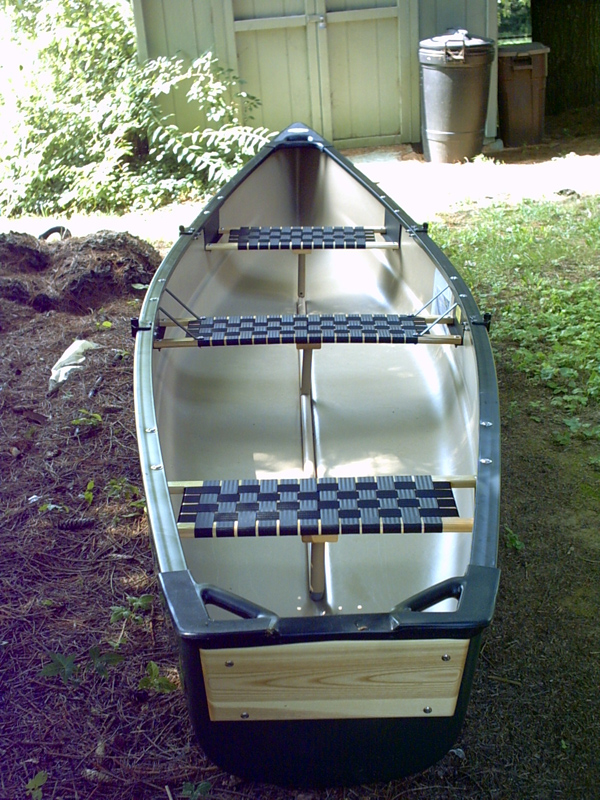 Most people use electrics as secondary motors on much larger boats than my Old Town square stern canoe, but for what I do, an electric outboard—not a trolling motor, please, that's something else —works very well. The Old Town is low enough at the stern that the typical electric outboard shaft for a transom mount is far longer than it needs to be; I found it best to shorten the shaft so that the motor and prop hang down about 8” under the stern.
Most people use electrics as secondary motors on much larger boats than my Old Town square stern canoe, but for what I do, an electric outboard—not a trolling motor, please, that's something else —works very well. The Old Town is low enough at the stern that the typical electric outboard shaft for a transom mount is far longer than it needs to be; I found it best to shorten the shaft so that the motor and prop hang down about 8” under the stern.
Despite their many good points, electrics do have some serious deficiencies as a primary propulsion unit, feebleness being the chief one. Two full-grown adults plus gear easily can weigh 500 pounds in the aggregate: my boat weighs 110 pounds, so even a first-quality motor with fresh batteries isn’t going to push it more than about 2.5 MPH. While it’s possible to get more powerful electrics, anything 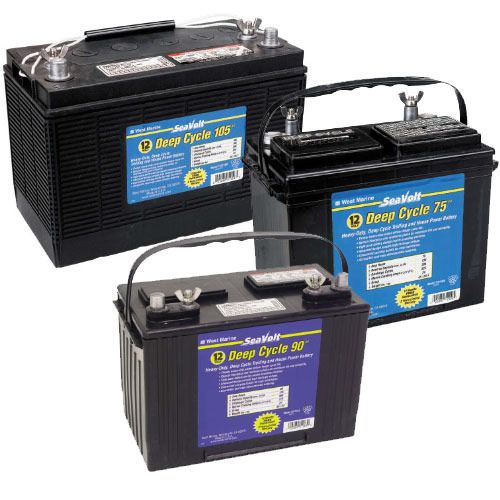 bigger uses at least a 24-volt system (really powerful ones are 36 or even 48 volts). A standard 12-volt marine deep cycle battery weighs about 40 pounds, so having to use two or more in series is a major-caliber PITA. Nor does moving to a bigger motor do much for speed because the weight of the extra batteries eats up a lot of the gain and there’s a point of diminishing returns, quickly reached, at about a maximum of 3 HP in a 12-volt system. (Electric outboards used to be rated by horsepower, but these days they’re rated by “pounds of thrust,” and what was originally a 3-HP motor is now rated at “55 pounds.” Anything more powerful requires more juice.) Many times on the New, the maximum thrust from my motor hasn’t been enough to overcome a fast current, requiring “assistance” with paddles get upstream. The problem is even worse when there’s any significant wind.
bigger uses at least a 24-volt system (really powerful ones are 36 or even 48 volts). A standard 12-volt marine deep cycle battery weighs about 40 pounds, so having to use two or more in series is a major-caliber PITA. Nor does moving to a bigger motor do much for speed because the weight of the extra batteries eats up a lot of the gain and there’s a point of diminishing returns, quickly reached, at about a maximum of 3 HP in a 12-volt system. (Electric outboards used to be rated by horsepower, but these days they’re rated by “pounds of thrust,” and what was originally a 3-HP motor is now rated at “55 pounds.” Anything more powerful requires more juice.) Many times on the New, the maximum thrust from my motor hasn’t been enough to overcome a fast current, requiring “assistance” with paddles get upstream. The problem is even worse when there’s any significant wind.
Still, they’re ideal for applications in which you need sustained low output, but when you need power, you need gas. For creeping silently along a shoreline hunting squirrels or popping for bass, there’s nothing better than an electric. But in a large lake where long distance have to be covered, or in a river with swift water, they’re sub-optimal.
Another significant drawback to electrics is “short legs.” My Minn-Kota draws 45 amp-hours at full throttle; and it’s so wimpy it has to be run at full throttle 90+% of the time. Battery life is maybe two to two-and-a-quarter hours on a full charge. On the New, where I rarely go more than a mile from my start point, this isn’t too big a big deal; but on bigger water—such as Claytor Lake—it’s entirely possible to run a battery flat just getting from the boat ramp to the fishing ground, believe me: I’ve done it.
So after years of managing in the New with electrics, I decided to see what a gasoline outboard could do for me. This decision was partly due to a desire to explore Claytor Lake, and partly because the Old Town goes with me to Oak Island NC every year, where I fish between the island and the mainland, and in the Intracoastal Waterway. Distances between the ramp and the spots I fish are fairly great and there are tidal currents to contend with.
The Old Town is rated for a 5-HP motor, so I started looking for one, fairly soon coming up against two hard facts: fantastically high prices of new small outboards, and a dearth of used ones.
![]() The best price I could find on a new 5-HP model was about $700-800 for the Briggs & Stratton (right). New 5-HP motors by other makers start at $1400, and can easily hit $1800-1900 depending on the exchange rate. I would have bought a B&S in a heartbeat but there was a catch: I planned to use it in salt water yearly. B&S specifically says their motor is not to be used in salt water, and if it is—even one time—the warranty is voided.
The best price I could find on a new 5-HP model was about $700-800 for the Briggs & Stratton (right). New 5-HP motors by other makers start at $1400, and can easily hit $1800-1900 depending on the exchange rate. I would have bought a B&S in a heartbeat but there was a catch: I planned to use it in salt water yearly. B&S specifically says their motor is not to be used in salt water, and if it is—even one time—the warranty is voided.
 I went looking for used ones, quickly finding out that at least in the New River Valley, if you want a small outboard, you have to buy a used boat with it. Some used motors of 15-30 HP showed up in newspaper and Pennysaver ads, invariably well-worn beaters mounted on the end of an equally battered jon boat. There was nothing with a 5-HP rating though: everything was 15-30 and up. All the local marinas told me that if I could find anything that small they’d be surprised. Small motors never show up in shops because they sell by word of mouth so fast. Many people use them as a “kicker” for big boats, or accessory power for sailboats, and there’s a brisk market for them in any condition at all. Several months of scanning newspaper ads and electronic bulletin boards produced no results worth mentioning. Inevitably I turned to E-Bay. While I did find a lot of motors without boats, almost anything in the 5-HP range was a clapped-out “mechanic’s special.” Anything described with the classic phrase “runs good” would be bid up well over $700 within a day or two of being posted. And—as strange as it seems, there are people who collect outboard motors (I am not making this up). “Vintage” motors, even ones that don’t run, command a hefty price from collectors and rebuilders, if only as parts sources.
I went looking for used ones, quickly finding out that at least in the New River Valley, if you want a small outboard, you have to buy a used boat with it. Some used motors of 15-30 HP showed up in newspaper and Pennysaver ads, invariably well-worn beaters mounted on the end of an equally battered jon boat. There was nothing with a 5-HP rating though: everything was 15-30 and up. All the local marinas told me that if I could find anything that small they’d be surprised. Small motors never show up in shops because they sell by word of mouth so fast. Many people use them as a “kicker” for big boats, or accessory power for sailboats, and there’s a brisk market for them in any condition at all. Several months of scanning newspaper ads and electronic bulletin boards produced no results worth mentioning. Inevitably I turned to E-Bay. While I did find a lot of motors without boats, almost anything in the 5-HP range was a clapped-out “mechanic’s special.” Anything described with the classic phrase “runs good” would be bid up well over $700 within a day or two of being posted. And—as strange as it seems, there are people who collect outboard motors (I am not making this up). “Vintage” motors, even ones that don’t run, command a hefty price from collectors and rebuilders, if only as parts sources.
I’m a patient man; moreover, given that sooner or later everything in the world is going to be sold on E-Bay, I knew that it was only a matter of time before something worth buying came along, and so it proved. I watched E-Bay for months, occasionally bidding on a motor and losing the bids. But lo, eventually there was listed an elderly Evinrude 5.5-HP “Fisherman” at a reasonable starting price, that I was assured “runs good.”
 Theoretically this motor was too powerful for my little boat but a well-used outboard wasn’t likely to produce as much horsepower as its original rating; nor was another half-horse excessive even if it did. The motor was amply documented with photos of its external condition with and without the cover in place. Though hardly pristine, it wasn’t nearly as scabrous as some of the things I’d bid on and it looked like a good chance. Furthermore, years of buying and selling on-line have honed my skill at recognizing an honest description: and this one was described honestly, “warts and all.” I took a stab at it and much to my surprise, I won the bid, all of $275.
Theoretically this motor was too powerful for my little boat but a well-used outboard wasn’t likely to produce as much horsepower as its original rating; nor was another half-horse excessive even if it did. The motor was amply documented with photos of its external condition with and without the cover in place. Though hardly pristine, it wasn’t nearly as scabrous as some of the things I’d bid on and it looked like a good chance. Furthermore, years of buying and selling on-line have honed my skill at recognizing an honest description: and this one was described honestly, “warts and all.” I took a stab at it and much to my surprise, I won the bid, all of $275.
Before I used it I took it to Danny’s Marine Service in Radford, who’d been recommended to me by Conrad Brothers Marina. Danny overhauled it, replacing all the internal gaskets and vetting the lower unit; changing all the fluids and adding a gas tank and fuel line. He was pretty positive about its condition, despite its age, pronouncing it “a good buy,” and said the compression on both cylinders was within specifications. It needed a new water pump but everything else was in good shape. All up his bill was about $250 inclusive. So for $225 less than a new B&S I ended up with a salt-water worthy engine that I know I can sell for almost what I have in it.
It is damned near as old as I am: by the serial number, it was built in 1948. It was originally designed for a 1:24 mix of gasoline and 30-W motor oil, but Danny recommended a 1:50 mix, arguing that modern 2-cycle oils are far, far better than those of 60 years ago. He assured me it would make a great deal less smoke and was perfectly safe. I took him at his word. 1:50 works OK and produces less smoke than the same mix in my Toro lawn mower does. Unfortunately, probably as a result, the motor’s  incredibly mixture-sensitive. The slightest maladjustment of the choke or the low-speed idle air bleed will stall it. It’s also a bitch to start after a season in the shed, so ether starting spray is now on the list of must-have boat equipment. But once it’s started it runs well, and is much quieter than I expected it would be.
incredibly mixture-sensitive. The slightest maladjustment of the choke or the low-speed idle air bleed will stall it. It’s also a bitch to start after a season in the shed, so ether starting spray is now on the list of must-have boat equipment. But once it’s started it runs well, and is much quieter than I expected it would be.
The first season I used it once on Claytor Lake, and it drove my boat well over twice the speed the Minn-Kota could attain. Then it went into the shed for a year, and this month came out for use in North Carolina, followed by two days on the New River and Claytor Lake, this past weekend.
It was barely tolerable in North Carolina, perhaps because it had been laid up so long. I was always able to get it started, but often I wondered if I’d be collecting disability insurance from shoulder injury caused by pulling the starter rope. I used ether spray liberally, running through half a can in four days, but in the end it did the job far better than the Minn-Kota could have. When I got home I wanted to run it in a bucket of water to flush the cooling lines, and it took me half an hour to get it to fire. I was not happy.
 My old friend Dave, with whom I've fished for 40+ years, had called last week and invited himself down to Blacksburg for a fishing weekend, to which I made no objection, as it has been a year or more since I went to my favorite spots on the New River. I decided to take a chance on the Evinrude even though the recent experience was a little unnerving. Saturday morning, not so very bright and early, we loaded the Old Town in the truck and threw an amazing amount of gear into it, and we were off.
My old friend Dave, with whom I've fished for 40+ years, had called last week and invited himself down to Blacksburg for a fishing weekend, to which I made no objection, as it has been a year or more since I went to my favorite spots on the New River. I decided to take a chance on the Evinrude even though the recent experience was a little unnerving. Saturday morning, not so very bright and early, we loaded the Old Town in the truck and threw an amazing amount of gear into it, and we were off.
I need not have worried. It ran like a champ on both the river and Claytor Lake. We put into the river on Saturday morning. I removed the top cover, gave it a hit of ether spray, and VROOM! It was up and running on the first pull! The rest of the day I’d get re-starts on the first or second pull, every time, without the spray. Although in North Carolina I’d adopted the practice of leaving the cover off, so as to more easily spray the intake, I never had to do that this weekend, not once. After I twiddled the choke to find the Exact Sweet Spot it wanted, and keep it there (the Sweet Spot changes as it warms up), and found the idle air bleed it liked, it would push that heavily laden boat along at 6.0 miles per hour. I’ll not break anyone’s neck with jackrabbit starts, but it no longer takes me nearly an hour to cover the mile back to the boat ramp when running back upstream.
 The fishing that day was OK but nothing spectacular, as it occasionally can be at Whitethorne. I did manage to boat a 17” and 16” smallmouth, plus a lot of little ones and a few red-eyes. The big fish had to go back into the water because of the 14-20" slot limit, but I was happy to catch them. They were deep-bodied, nice fat fish, and fought like tigers. The 16” at right almost drowned me. I caught it while I was wading, and as I guided him back to the boat, I tripped and fell into a hole. This is what comes of watching the fish and concentrating on the line tension, and not thinking about where I placed my feet on rough bottom.
The fishing that day was OK but nothing spectacular, as it occasionally can be at Whitethorne. I did manage to boat a 17” and 16” smallmouth, plus a lot of little ones and a few red-eyes. The big fish had to go back into the water because of the 14-20" slot limit, but I was happy to catch them. They were deep-bodied, nice fat fish, and fought like tigers. The 16” at right almost drowned me. I caught it while I was wading, and as I guided him back to the boat, I tripped and fell into a hole. This is what comes of watching the fish and concentrating on the line tension, and not thinking about where I placed my feet on rough bottom.
The real test was next day at Claytor Lake. I’ve fished there many times, and much prefer the river, because the problem with a lake is that everything looks the same 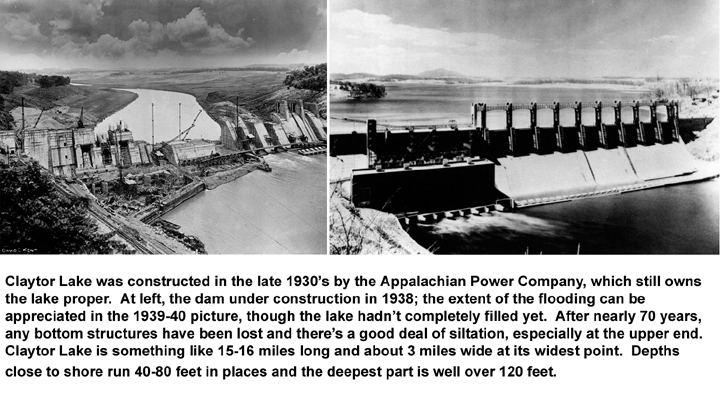 when you're floating on the top of it. You can “read” a river and figure out where fish ought to be based on current and bottom and obstacles; but Claytor is so damned deep (40 feet at the periphery, well over 100 feet in the middle) it’s impossible to tell what’s below the surface. And it’s so old (it was built in 1938) that whatever bottom structures might once have been there are long since gone, rotted away or covered by silt. Nor did Dave’s “fish finder” find us any fish.
when you're floating on the top of it. You can “read” a river and figure out where fish ought to be based on current and bottom and obstacles; but Claytor is so damned deep (40 feet at the periphery, well over 100 feet in the middle) it’s impossible to tell what’s below the surface. And it’s so old (it was built in 1938) that whatever bottom structures might once have been there are long since gone, rotted away or covered by silt. Nor did Dave’s “fish finder” find us any fish.
Still, I’ve often caught fish there, including a couple of small stripers and a nice fat catfish, not to mention many smallmouth. We entered the water not in the lake itself, but at the Rock House Marina on Peak Creek. Peak Creek is the major tributary into the lake, and the marina’s several miles upstream from the entry point. Thus we had a long run into the main body, and a long run back, and a couple of miles to cover while we were on the lake proper.
Claytor is unfortunately infested with jet-skiers and the sort of infantile ninny who buys a boat with a 200+ horsepower engine and drives it at top speed, all the time. (A few months ago, one of these clowns killed two people at Smith Mountain Lake—where the problem is even worse—by running his turbo-charged speedboat at 110 MPH up and OVER a boat in front of him. 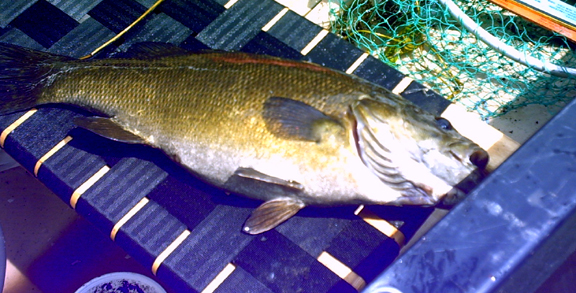 Why didn’t he see it? Because he was drunk, that’s why!) It isn’t that bad at Claytor, but it's bad enough. Even a portly pontoon party barge moving at reasonable speed can put up a big enough wake to swamp a canoe; and there were the omnipresent drivers of over-engined “Bass Buggies” and the never-sufficiently-to-be-cursed water skiers.
Why didn’t he see it? Because he was drunk, that’s why!) It isn’t that bad at Claytor, but it's bad enough. Even a portly pontoon party barge moving at reasonable speed can put up a big enough wake to swamp a canoe; and there were the omnipresent drivers of over-engined “Bass Buggies” and the never-sufficiently-to-be-cursed water skiers.
We pooched down Peak Creek, stopping here and there to drown some worms. At first I left the motor idling when we stopped, unsure about how well it would behave; but by the time we’d finished the 3 miles or so to the lake, I no longer had any concerns. It was behaving perfectly, even better than it had the day before. The fishing was, to say the least, lousy; but I got a few, mostly bluegills with delusions of grandeur and a couple of red-eye who were smallmouth wanna-bees. Once in the main lake we had another 2-3 mile run down to a couple of spots we wanted to try, and I opened the throttle all the way up. The mighty 5.5-HP Evinrude throbbed and wailed and rattled, driving us at 6 MPH according to my  portable GPS unit.
portable GPS unit.
While we were hove to over one spot,  a DGIF boat came up to check licenses and gear; the senior warden remarked, “You guys are sure brave to take a canoe out in this lake! You’d be better off coming in mid week when there’s not so much traffic!” I told him it was the only boat I had and that, so long as I kept away from the jet-skiers and big boats, we did OK. I don’t much relish the thought of being dumped over by somebody’s prop wash in 40-100 feet of water, but a man’s gotta do what a man’s gotta do…Actually, we did ship water now and then from crossing a wake, but never really had much to worry about. (I forgot to ask them what shot sizes are legal for jet-skiers, damn it.)
a DGIF boat came up to check licenses and gear; the senior warden remarked, “You guys are sure brave to take a canoe out in this lake! You’d be better off coming in mid week when there’s not so much traffic!” I told him it was the only boat I had and that, so long as I kept away from the jet-skiers and big boats, we did OK. I don’t much relish the thought of being dumped over by somebody’s prop wash in 40-100 feet of water, but a man’s gotta do what a man’s gotta do…Actually, we did ship water now and then from crossing a wake, but never really had much to worry about. (I forgot to ask them what shot sizes are legal for jet-skiers, damn it.)
This, incidentally, was the first time I’ve ever been checked by a game warden while fishing. Once or twice I’ve encountered them hunting, and while I knew they did lake patrols, I'd never encountered them before. Of course all my paperwork and gear was in order (I heard one say, “Yeah, they got everything,” and explain to another who seemed to be a trainee why I had a registration number on a canoe) so we had no problems. Imagine being paid to go boating all day!
In the course of the day, we covered a little over 11 miles from the marina down and back along the same route. After that much time I was glad to get on shore: I’m getting too old to sit in a cramped boat like that all day, but unlike the river, there’s no place to get out along the lake shore, as almost all of it is private property.
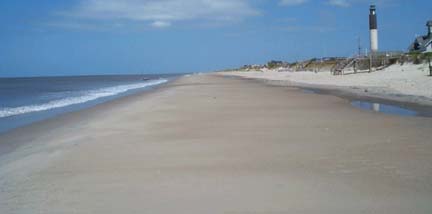 I’ve been thinking about the difference in performance here compared to North Carolina. I think perhaps the water temperature had something to do with it: the lake is much cooler than the ocean was, so maybe the engine temperature was under better control. I can’t imagine that the lack of salt in the water made any difference, though several hours of running time in fresh water is probably the best thing that’s happened to that motor in years.
I’ve been thinking about the difference in performance here compared to North Carolina. I think perhaps the water temperature had something to do with it: the lake is much cooler than the ocean was, so maybe the engine temperature was under better control. I can’t imagine that the lack of salt in the water made any difference, though several hours of running time in fresh water is probably the best thing that’s happened to that motor in years.
Perhaps the altitude matters, too. The surface of the lake (and the river) is more than 1800 feet above sea level, and the air is cooler and drier than at the beach. My old private pilot training emphasized the importance of humidity (high in NC, low in VA) and temperature (easily 15 degrees hotter in NC) and altitude in the performance of gasoline engines. I suppose that when Danny adjusted my air bleeds he set them for prevailing conditions here. If so, perhaps it’s no wonder the Evinrude didn’t much care for sea level and 95+ degrees, with 90% humidity!
Despite its age and infirmities, I think perhaps the best thing for it is it be used as much as I can use it, so maybe another trip is in order in the next few months. If it continues to run this well in future seasons I won’t need a new one after all!
Update, July 2009
The Evinrude has given up the ghost. I took it to the beach again this year, and the second day out we went up the Lockwood Folly River quite a ways: it died leaving us stranded in mid-stream. We got a tow back to a nearby marina, where I was able to effect some emergency repairs that lasted just long enough to get us back to our launch ramp. At that point it laid down and died like an overworked horse. It simply wouldn't start at all, and I didn't see any water coming out of the cooling outlet, always a bad sign. It had always been a balky, cranky, hard-starting bitch-and-a-half-with-ear-flaps, but it would eventually start until last Tuesday when no matter how liberal my use of ether spray it didn't even cough. Besides almost certainly having a dead water pump, I think the magneto coils need replacement.
I've struggled with it long enough. No more: I'm 61 years old and there's no point in getting a heart attack fruitlessly pulling the starting rope. I have all of $500 in it, and it's worth almost that much parted out. So with five days left in the week and a dead motor, if I was going to fish at all I had no realistic option but to buy a new one locally. It's damned near impossible to find a new small outboard at a reasonable price. A local dealer offered me a 5-HP Honda for $2450!! After half an hour on the phone it was clear I wasn't going to find much but I was pretty desperate. So I and my fishing partner Rick and his father started a shopping tour of the local marine dealers. We found that it was possible to find some used motors...but they were already attached to boats and you had to buy the boat too! It also seems that in coastal North Carolina, "small" means 30 to 90 HP which wasn't much help.
Then we stopped at Black Barry's Marine Service. (Barry isn't black: he's a huge white guy with a North Carolina drawl and an uncanny resemblance to the late comedian John Candy.) I walked in after having stopped at three or four other places and despairingly asked if he had any small outboards. He replied, "I got a Yamaha 2.5 HP Ill sell you for $785 plus tax!"
I was a little hesitant. The deal was sweet: MSRP on this motor is almost $1100, and the price was excellent, but...it was so damned small! The Evinrude could move my laden boat at about 7 MPH (when it was running) but with less than half the horsepower, how fast could I expect to go? On the other hand, this little motor had a lot of other virtues, besides being brand new and coming with a 3-year warranty. First it was light (37 pounds, 19 pounds less than the Evinrude) and second, it was a four-stroke. I hate two-stroke engines of any kind, having had several of them inflicted on me over the years: it being a 4-stroke was a real plus. I looked at the spec sheet: it was rated to run at 5200-5500 RPM, the same as the Evinrude; and it had a 3-bladed propeller, not a two-bladed one. Rick pointed out that it likely had as much torque as a 46-year-old 5.5 HP and the price couldnt be beaten. I bit.
It was the right decision. That little motor could push the boat at 7 MPH against a stiff tidal current, and at 9.5 MPH with the tide! It starts with one pull every time (that's going to take some getting used to). It idled without stalling. It tootles along merrily at trolling speed. It ran flawlessly all four days we used it, and I'm delighted with it. Its only shortcoming is the lack of a reverse gear: you have to physically turn the motor 180 degrees in its mount to run in reverse, which is a PITA, but I can live with it. Mrs NRVO was less than enthusiastic about a new motor, but after having bought into the trailer, she took it in stride.
| HUNTING | GUNS | DOGS |
| FISHING & BOATING | TRIP REPORTS | MISCELLANEOUS ESSAYS |
| CONTRIBUTIONS FROM OTHER WRITERS|
| RECIPES |POLITICS |